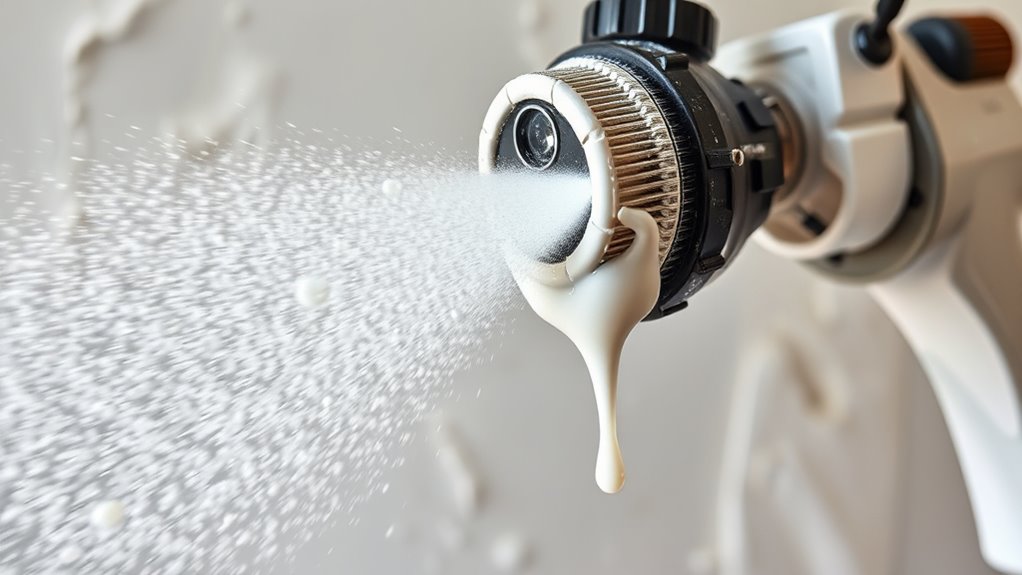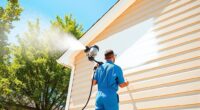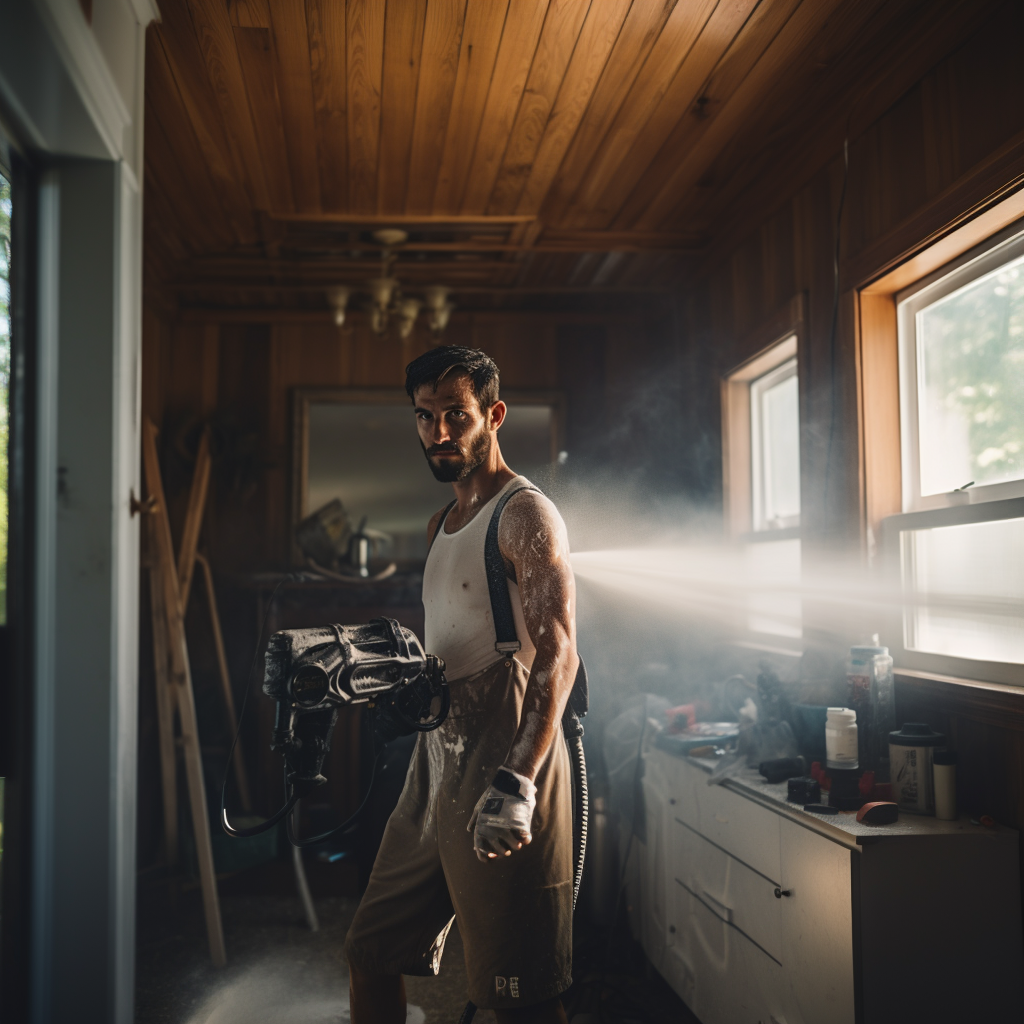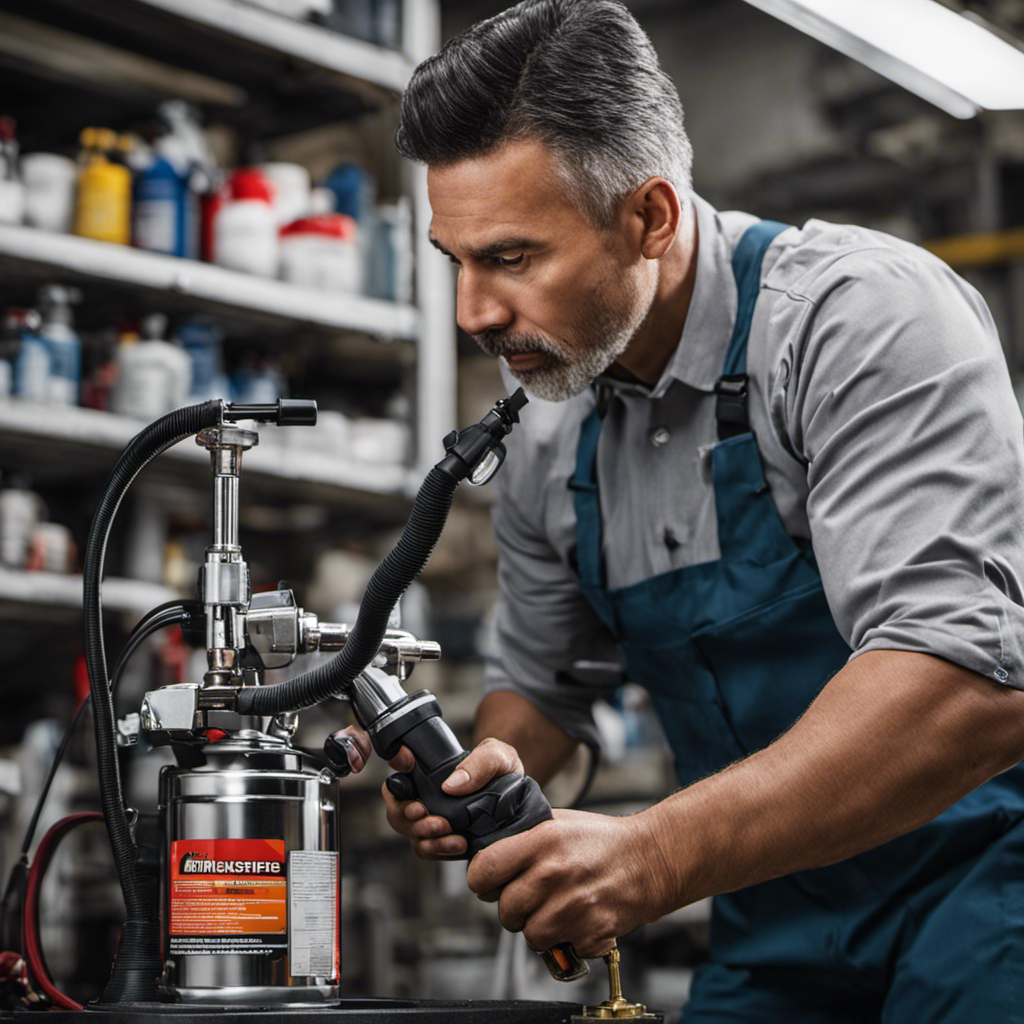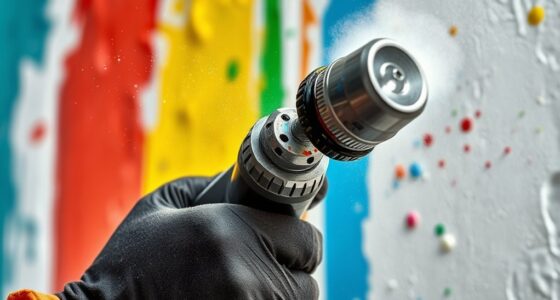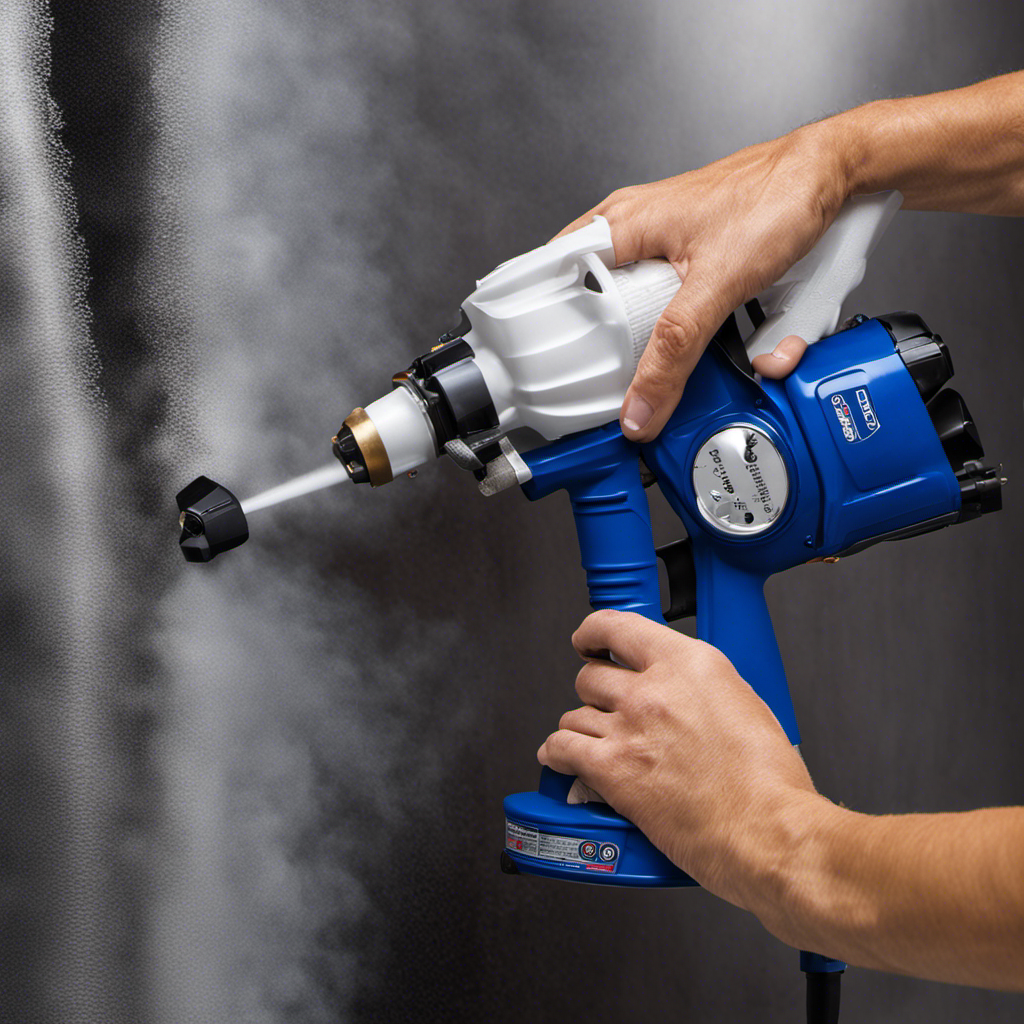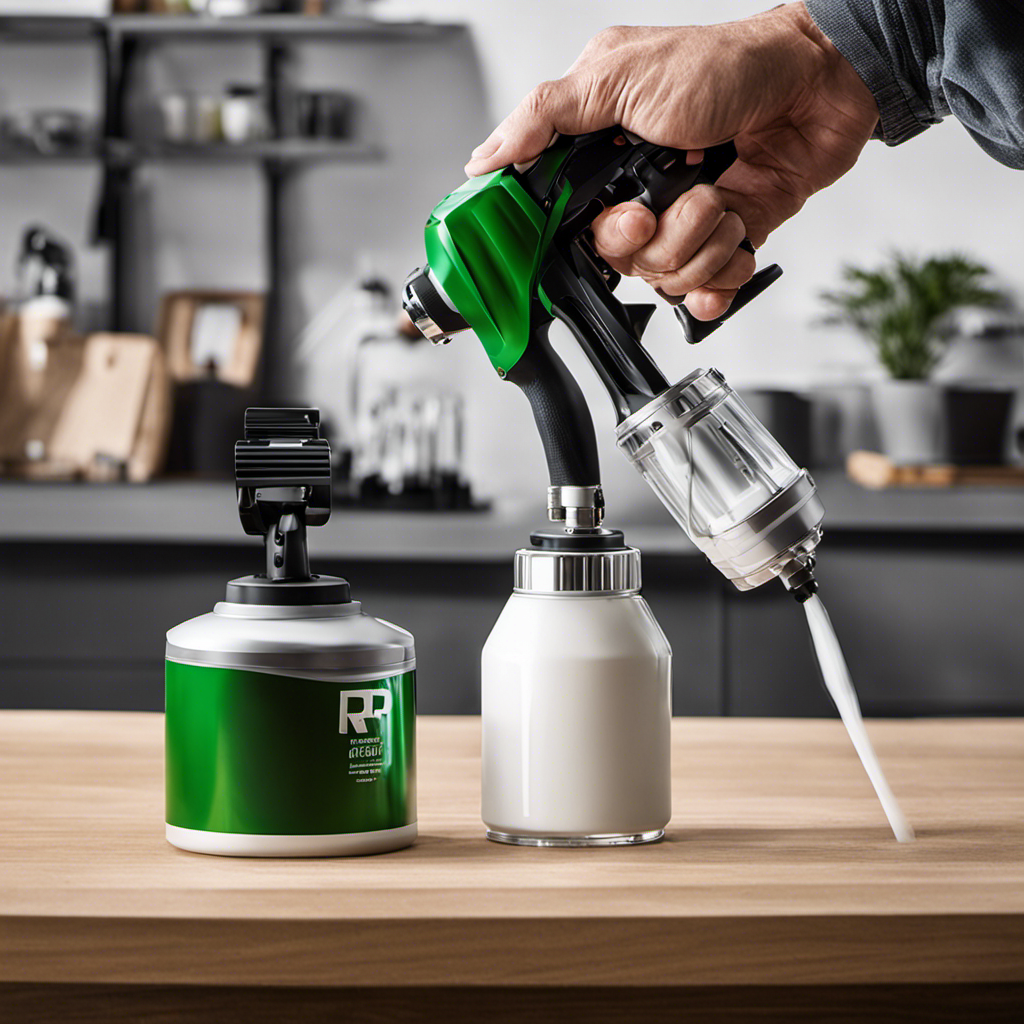To fix your paint sprayer wasting too much paint, start by adjusting the flow settings to reduce paint output. Regularly clean and inspect the nozzle to prevent clogs and guarantee a smooth spray pattern. Keep a steady distance from the surface and move consistently for even coverage, which minimizes overspray. Properly preparing your paint also helps it flow better. These simple steps can greatly boost your efficiency—more tips await to help you get it right.
Key Takeaways
- Adjust the paint flow setting gradually to prevent excess application and reduce waste.
- Regularly inspect and clean or replace nozzles to ensure an even spray pattern.
- Maintain proper distance and steady movement for consistent coverage and minimal overspray.
- Properly stir and prepare paint to ensure smooth flow and prevent clogs, saving paint.
- Use the appropriate spray equipment suited for your project to enhance efficiency and reduce paint usage.

If you want to improve your paint sprayer’s performance, addressing efficiency issues is essential. One of the most common problems is using too much paint, which can lead to waste, mess, and increased costs. To fix this, start by examining your paint flow adjustments. Many sprayers have adjustable settings that control how much paint is released with each pass. If the flow is set too high, you’ll notice thick coats, drips, and excessive paint usage. Lowering the paint flow to the appropriate level allows you to apply the right amount of paint evenly, reducing waste and improving finish quality. Experiment with these adjustments gradually, testing on scrap material until you find the ideal setting that balances coverage with minimal overspray.
Another critical factor in reducing paint consumption is proper nozzle maintenance. Over time, nozzles can become clogged or damaged, which affects spray pattern and flow consistency. Regularly inspect your nozzle for any debris or buildup and clean it thoroughly according to the manufacturer’s instructions. A clean nozzle ensures a uniform spray pattern, which means you won’t need to apply multiple coats or go over the same area repeatedly. If you notice uneven spray or sputtering, it’s often a sign that your nozzle needs attention. Replacing worn or damaged nozzles can drastically improve paint efficiency, as a properly functioning nozzle delivers paint smoothly and precisely, reducing unnecessary over-application.
In addition to adjusting paint flow and maintaining your nozzle, consider the importance of your spray technique. Holding the sprayer at a consistent distance from the surface and moving at a steady pace helps ensure even coverage without excessive paint use. If you rush or hold the sprayer too close, you’ll likely waste more paint due to overspray and drips. Practice steady, controlled movements and maintain the recommended distance specified by your sprayer’s manufacturer. This approach complements your paint flow adjustments and nozzle maintenance, maximizing efficiency.
Finally, always shake or stir your paint thoroughly before spraying. Properly mixed paint flows more smoothly through the nozzle, preventing clogs and uneven spray patterns. When your paint is well-mixed, you’ll notice fewer stops and starts, which conserves paint and enhances overall efficiency. Additionally, choosing the right spray equipment suited for your project can make a significant difference in achieving efficient coverage. Combining these practices—fine-tuning paint flow, maintaining the nozzle, refining your technique, and ensuring the paint is properly prepared—will greatly reduce paint wastage, saving you time and money while achieving professional-looking results.
Frequently Asked Questions
Can I Adjust My Paint Sprayer’s Pressure Settings for Better Efficiency?
Yes, you can adjust your paint sprayer’s pressure settings to improve efficiency. By tweaking the pressure adjustment, you can control the spray pattern and paint flow, reducing excess paint use. Lowering the pressure slightly often results in a finer, more even spray pattern, which minimizes waste. Make small adjustments and test spray to find the best settings for your project, ensuring better coverage with less paint.
Does Using Thicker Paint Affect Spray Pattern and Paint Consumption?
Ever wonder if thicker paint could be throwing off your spray pattern? It definitely can. When paint’s too thick, it clogs the nozzle and disrupts spray consistency, causing uneven coverage and increased paint use. You might notice drips or missed spots, wasting paint and time. To fix this, thin your paint properly, ensuring it flows smoothly. This keeps your spray pattern steady and helps you use paint more efficiently.
How Often Should I Clean My Paint Sprayer to Prevent Excess Paint Use?
To prevent excess paint use, you should establish a regular cleaning schedule for your sprayer. Aim to clean it after every few hours of continuous use or at the end of each project. Maintaining proper maintenance frequency guarantees your sprayer operates efficiently, reducing paint waste and preventing clogs. Consistent cleaning not only improves spray pattern consistency but also extends your equipment’s lifespan, saving you money and time in the long run.
Are There Specific Nozzle Types That Help Reduce Paint Wastage?
Noticing nozzle types and spray patterns can considerably save paint. Specific nozzles, like adjustable or narrow spray patterns, minimize waste by focusing paint precisely where you need it. Look for nozzles designed for controlled, consistent spray patterns—these help reduce overspray and excess paint usage. By choosing the right nozzle types, you’ll improve efficiency, eliminate excess, and ensure every drop counts, making your painting project more precise and economical.
Can a Higher-Quality Paint Sprayer Save Me Paint in the Long Run?
A higher-quality paint sprayer can definitely save you paint in the long run. It offers better spray consistency, ensuring you use only what you need without excess overspray. Plus, improved paint quality delivery reduces waste and touch-ups, making your projects more efficient. Investing in a better sprayer means you’ll finish faster and use less paint overall, ultimately saving money and reducing waste over time.
Conclusion
By paying close attention to your spray technique and equipment settings, you can gently guide your paint sprayer toward a more balanced performance. Small adjustments can help your project flow more smoothly, reducing waste and ensuring a cleaner finish. Remember, a little refinement goes a long way—sometimes, it’s about fine-tuning rather than overhauling. With patience and care, you’ll find your sprayer working more efficiently, leaving you with a beautifully finished result and a happier wallet.
Franz came aboard the Paint Sprayer Zone team with a background in both journalism and home renovation. His articulate writing style, combined with a passion for DIY projects, makes him an invaluable asset. Franz has a knack for breaking down technical jargon into easy-to-understand content, ensuring that even the most novice of readers can grasp the complexities of paint sprayers.
